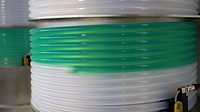Against this background, Clariant has developed Exolit® OP, a series of non-halogenated flame retardants with superior properties. Already at relatively small amounts of less than 15 to 20%, Exolit OP is highly effective. Its addition has only minor impact on the material properties of the plastic. Other significant plastic advantages that are flame-retarded with Exolit OP are excellent mechanical and electrical properties, as well as laser markability and the ability to be dyed in almost all colors. The flame retardant has established itself in the field of fiberglass-reinforced polyamides (PA). Exolit OP also provides effective flame protection for the thermoplastics polyethylene terephthalate (PET) and polybutylene terephthalate (PBT), which are often used in E&E. Various thermoplastic elastomers and epoxy resins are also successfully flame-retarded with Exolit OP.
How Exolit OP Works
Exolit OP is based on metal phosphinates and features high thermal stability up to 350 °C. In polyamides, the flame retardant deploys its effects in a combination of a gaseous and a solid phase mechanism, which reduces the smoke gas density and prevents the formation of corrosive gases. The formation of a thick, partially intumescent cover layer keeps the heat release rate low. Compounds that have been treated with Exolit OP can easily meet the standards of the V02 class according to UL 94, the leading standard for fire protection in E&E.Polymers that are flame-retarded with Exolit OP also feature outstanding mechanical properties. Due to the low dosage of the flame retardant, e-modulus, tensile strength and impact strength remain at a sufficient level, unlike in compounds that have not been flame-retarded. The compounds can reach crucial electrical parameters, such as the Comparative Tracking Index (CTI) or the dielectric strength, without problems. The polymers also feature good overall insulation properties.






.png?height=200&t=1722533320&width=200)